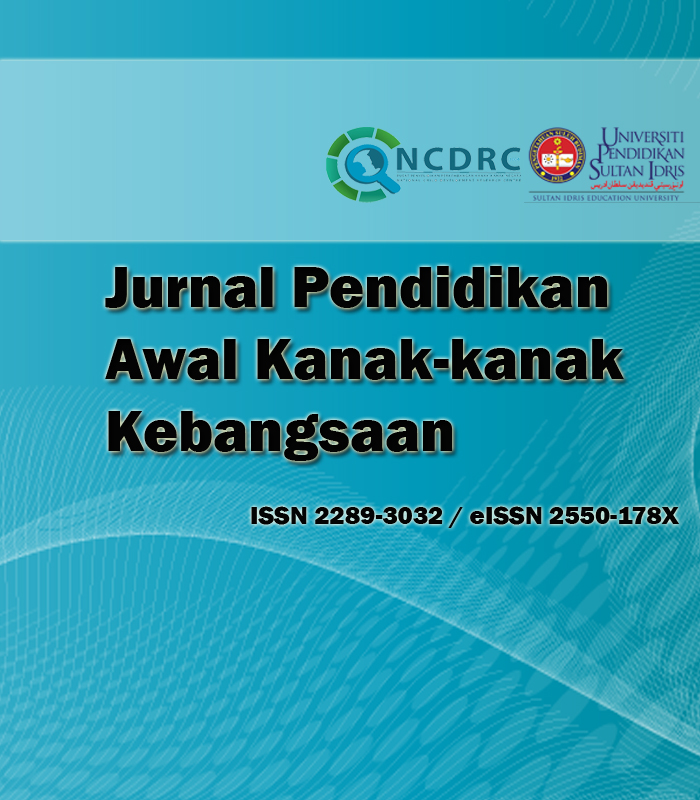The practice of multisensory technique towards reading skills of open syllables by preschoolers
DOI:
https://doi.org/10.37134/jpak.vol10.1.5.2021Keywords:
multisensory technique, open syllable, reading skills, children, preschoolAbstract
Unable to read has a significant impact on language acquisition that can contribute to children failing at school. Therefore, teachers must utilise methods that are in accordance with the children’s ability during their early stages of reading development to prevent them from experiencing difficulties in a formal school environment. The objective of this study was to observe the practice of multisensory technique towards the benefit of children’s skills in reading open syllables. By using structured observation, three children were observed using three different multisensory activities such as ‘sand letters’, ‘alphabet jump’, and ‘tactile alphabet’. 16 open syllables were identified which are ‘ma’, ‘ho’, ‘su’, ‘gi’, ‘pa, ‘du’, ‘me’, ‘ga’, ‘do’, ‘bi’, ‘te’, ‘pu’, ‘so’, ‘ri’, ‘ta’ and ‘la’ by using a checklist item from LINUS instrument have been analysed descriptively by looking to the appearance of children’s reading skills. The study showed that multisensory technique was able to assist in children’s reading skills of open syllables even if they come from different language backgrounds. In addition, this technique helped the children to avoid confusion between Malay and English open syllables with the presence of stimulus during reading activity. This proved that an environment rich with stimulus are important for children’s development. It provides important factors for teachers in delivering meaningful experiences during children’s learning.
Downloads
References
Ab. Jalil, N., Kamarudin, Z. & Ab. Jalil, H. (2018). Multisensory design elements in stimulating learning environment for dyslexic children. International Journal for Studies on Children, Women, Elderly and Disabled, 3, 29-48.
Abu Bakar, M. (2017). Children learn to reading by using bilingual story book. International Journal of the Malay World and Civilisation, 5(2), 29- 41.
Allard, S., Levine, K. J., Tenopir, C. (2009). Design engineers and technical professionals at work: Observing information usage. Journal of the American Society for Information Science & Technology, 60, 443–454.
Asha, N., Siraj, S., Ismail, H., Omar, R., Samad, S. A., & Ninari, E. F. (2020). Penggunaan big book dalam kalangan guru tadika untuk perkembangan literasi kanak-kanak. Jurnal Pendidikan Awal Kanak-Kanak Kebangsaan, 9, 106-112.
Bakar, N. F. & Abd Rahman, M. J (2018). Prevalance on at risk child dyslexia among preschoolers. Prosiding Seminar Kebangsaan Majlis Dekan Pendidikan Universiti Awam.
Bakar, S. (2012). VAKT method and name writing. Artikel Penyelidikan Tindakan PISMP Pemulihan amb. Januari 2009, Seminar Penyelidikan Tindakan IPG KBL Tahun 2012, 177-190.
Che Mat, A., Awang, A.& Ismail, M. (2016). Reading skill and Jawi writing for Quranic and Farduh Ain classes (KAFA) for standard 5: A case study. Proceedings for the International Conference on Education, Islamic Studies and Social Sciences Research.
Ching, C. S., Arshad, M., & Ayob, A. (2018). Reassessment on teaching and learning in early reading International Journal of Education, Psychology and Counseling, 3(10), 1-8.
Cibrian, F. L., Tentori, M., & Weibel, N. (2016). A Musical interactive surface to support the multi-sensory stimulation of children. Journal of Medical Systems, 16, 241-244.
Elias, R. & Sulaiman, S. (2016). The using of Inst card to enhance early spelling with close syllable for special needs children. Asian Education Action Research Journal, 5, 27-39.
Fiani, E. A. (2012). The influence of multisensory approach for logical-mathematics intelligence for children A-classs at Kabupaten Kendal Children Centre. Skipsi. Semarang. Universitas Negeri Semarang (unpublished).
Gordon, A. M., & Browne, K. W. (2017). Beginnings and beyond: Foundation in early childhood education. Wadsworth Pub Co.
Gori, M. (2015). Multisensory Integration and calibration in children and adults with and without sensory and motor disabilities. Multisensory Research, 28, 71-99.
Ismail, H. (2019). Bukan generasi remote control. Terbitan Kata-Pilar Books.
Jasmine, J. & Connolly, M. (2015). The use of multisensory approaches during center time, through visual, auditory, and kinesthetic-tactile activities, to enhance spelling accuracy of second grade students. Journal of Education and Social Policy, 2(1), 12- 19.
Jun Long, G. L., & Che Mustafa, M. (2020). Early childhood teachers’ perspectives on the effectiveness of teaching vocabulary through nursery rhymes. Jurnal Pendidikan Awal Kanak-Kanak Kebangsaan, 9, 9-17.
Kalayci, S., & Humiston, K. R. (2015). Students‟ Attitudes towards collaborative tools in a virtual learning environment. Educational Process: International Journal, 4(1- 2), 71-86.
McKechnie, L. E. F. (2008). Observational research. In Given, L. M. (Ed.), The SAGE encyclopedia of qualitative research methods (pp. 574–577). Sage.
Md Maliki, N. S., & Mohd Yasin, M. H. (2017). Application of Multisensory in learning alphabets identification skills for special education students. Journal of ICSAR, 1(2), 150-154.
Ministry of Education (2013). Malaysian Education Blueprint 2013-2025. https://www.moe.gov.my/menumedia/media-cetak/penerbitan/dasar/1207-malaysia-education-blueprint-2013-2025/file
Mwoma, T. (2017). Children‟s reading ability in early primary schooling: Challenges for a Kenyan rural community. Issues in Educational Research, 27(2), 347-364.
Nainggolan, D., & Delrefi, S. (2017). The influence of Fernald method on eraly reading ability for children in Paud Mekar Sari Penarik Mukomuko. Jurnal Potensia, 2(1), 71-78.
Rostan, N. N. A., Ismail, H., & Mohamad Jaafar, A. N. (2020). The use of multisensory technique in the teaching open syllables reading skill for preschoolers from a teacher’s perspective. Southeast Asia Early Childhood Journal, 9(2), 155-165.
Setyawati, F. F. (2017). The effectiveness of multinsensory to improve early reading ability for Tunagrahita children second class. Slb Negeri Semarang.
Subramaniam, V., Mallan, V. K., & Mat, N. H. C. (2013). Multi-senses explication activities module for dyslexic children in Malaysia. Asian Social Science, 9(7), 241.
Tarasat, S. & Daud, A. (2014). The effect of reading on using basic software for children achievement at preschool. Institut Pendidikan Sultan Hassanal Bolkiah, Universiti Brunei Darussalam.
The Minnesota Literacy. (2015). Multisensory activities to teach reading skills. Minnesota.





